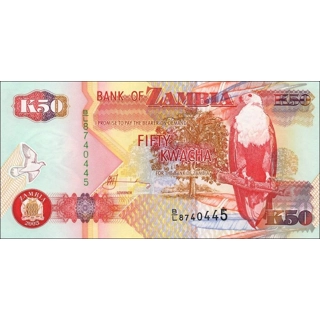Product Description
SCWPM.#37c - TBB.#B138c
Date: ND (demonetized 31.12.2015)
Grade: Unc - Signature: 11 - Prefix: BJ
Description: Colour: Red. - Front: Coat of arms; tree; fish eagle perched on branch.
Back: Zebra head; copper refining at Nkana mine; Freedom Statue in Lusaka.
Solid security thread. - Watermark: Fish eagle.
Printer: unknown - Size: 140 x 70 mm. - Material: Paper.
More about: Zambia,
landlocked country in south-central Africa. It is situated on a high plateau and takes its name from the Zambezi River, which drains all but a small northern part of the country.
Large parts of Zambia are thinly populated. Much of population is concentrated in the country’s most developed area—known as the Line of Rail—which is served by the railway linking the Copperbelt with Lusaka, the capital, and with the border town of Livingstone.
Ethnic and linguistic composition.
Most Zambians speak Bantu languages of the Niger-Congo language family and are descended from farming and metal-using peoples who settled in the region over the past 2,000 years. Cultural traditions in the northeast and northwest indicate influences and migrations from the upper Congo basin. There are also some descendants of hunters and gatherers who seem to have been pushed back into the Kalahari, the Bangweulu and Lukanga swamps, and the Kafue Flats. In the 19th century invaders arrived from the south: the Ngoni settled in the east, while the Kololo briefly ruled the Lozi in the upper Zambezi valley. Europeans began to enter in significant numbers in the late 19th century.







